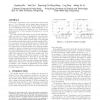1051 search results - page 102 / 211 » An algorithm for the principal component analysis of large d... |
KDD
2009
ACM
14 years 8 months ago
2009
ACM
In large social networks, nodes (users, entities) are influenced by others for various reasons. For example, the colleagues have strong influence on one's work, while the fri...
EDBT
2009
ACM
14 years 3 days ago
2009
ACM
Given a set P of products, a set O of customers, and a product p P, a bichromatic reverse skyline query retrieves all the customers in O that do not find any other product in P t...
ISBI
2004
IEEE
14 years 9 months ago
2004
IEEE
We propose a novel method for reconstructing a complete 3D model of a given anatomy from minimal information. This reconstruction provides an appropriate intra-operative 3D visual...
PCM
2007
Springer
14 years 2 months ago
2007
Springer
The two-dimensional Principal Component Analysis (2DPCA) is a robust method in face recognition. Much recent research shows that the 2DPCA is more reliable than the well-known PCA ...
SIGDIAL
2010
13 years 6 months ago
2010
A central problem in Interactive Question Answering (IQA) is how to answer Follow-Up Questions (FU Qs), possibly by taking advantage of information from the dialogue context. We a...


